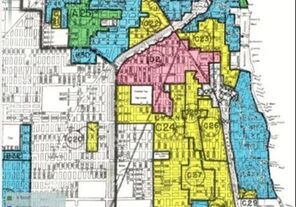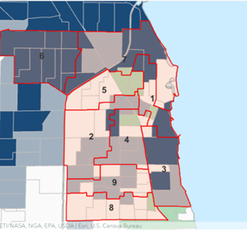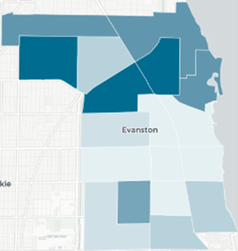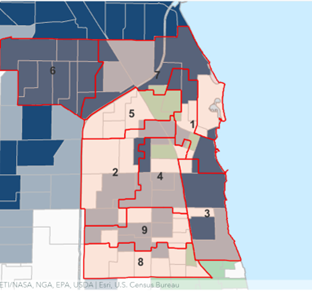Maps can be found here. Part of the intent behind zoning is to give cities legal tools to regulate how land is used and what types of buildings are built in certain areas. In practice, however, zoning has served as a moral document that may not reflect the values of the current community. For example, redlining, a practice from the early 1900s, enabled the government to create maps of cities where Black neighborhoods were marked in red as “hazardous,” to warn white lenders, builders, bankers, and insurers from offering New-Deal-era financial support to Black homeowners. In Evanston, these practices worked in tandem with the City’s zoning codes up until the Supreme Court ruled redlining as unconstitutional in 1968. Yet, zoning still remains. While it is no longer be a practiced law, some of redlining’s effects still last today through zoning codes. These maps and more show how much redlining’s impact (racial disparities, income inequality, life expectancy, housings cost, etc.) is still prevalent in our communities. There are some benefits to good zoning policy. Zoning can prevent dangerous land uses like landfills, gas stations, and chemical plants, from being near residential areas. It also can prevent unprecedented building shapes and sizes, like some of the old buildings we see in New York City before they created the country’s first comprehensive zoning codes. But who exactly does zoning benefit? Historically, Evanston’s zoning code prevented dangerous land uses – except in Black neighborhoods where they were zoned for commercial use rather than residential. Evanston’s white neighborhoods only allow single family homes, while Black neighborhoods are expected to bear the brunt of Evanston’s apartments and townhomes. This is what made our team interested in starting this Equitable Zoning Project, to learn how zoning currently is and how it should reflect both the needs and values of communities in Evanston and individual Evanstonians. We are partnering with the City of Evanston and the Chicago Metropolitan Agency on Planning to gather feedback on how people who aren't usually included in zoning discussions are impacted by zoning in our community. We are looking to get feedback from the whole community, with a special focus on the following:
How the Community Can Help Sign up for a focus group or survey: Here you can have your voice heard on how the city should make decisions related to zoning, and how zoning can be more equitable and beneficial to all residents. Learn more about the project by visiting the Joining Forces equitable zoning project webpage and signing up for the Joining Forces Mailing List, where you will receive updates about the project, as well as updates about Joining Forces’ advocacy initiatives and monthly membership meetings.  Percent White Population by Census Tract  Evanston HOLC Redline Map, 1935  Income disparities by ward. Tan is lower income, navy is higher income  Average life expectancy, darker blue = lower life expectancy  Excessive housing costs, based on how much the residents make compared to cost of housing in their neighborhoods. Darker blue = higher excessive costs  Access to healthy foods. Darker = less access.
0 Comments
Leave a Reply. |
|
© COPYRIGHT 2018. ALL RIGHTS RESERVED.
|







